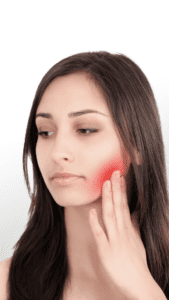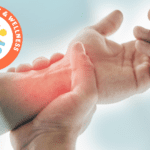TMJ Disorders & Treatments
In our fast-paced, stress-laden lives, we often unknowingly carry the weight of our tensions and anxieties in our bodies. One area that frequently bears the brunt of this strain is the temporomandibular joint, or TMJ. Temporomandibular disorder (TMD), is a common yet often misunderstood condition that can lead to discomfort, pain, and reduced quality of life. In this blog post, we’ll delve into what TMJ disorder is, explore its anatomy, and investigate its potential causes. Additionally, we willdiscuss the various effective treatments that provide relief for those suffering from this condition.
Understanding TMJ Disorder
The temporomandibular joint is a complex structure that connects your jaw to your skull. It plays a pivotal role in activities like chewing, speaking, and even yawning. TMJ disorders refer to a group of conditions characterized by pain and dysfunction in the jaw joint and surrounding muscles that can manifest in a variety of ways. Individuals with TMJ disorder often experience pain in the jaw joint, which may radiate to the ears or neck. In addition, persistent headaches, both tension-type and migraine, can be a common consequence of this condition. Patients may also notice clicking or popping sounds when they open and close their mouths. Jaw stiffness and limited mobility are also telltale signs of TMJ disorder. Bruxism, or teeth grinding, is often linked to this condition, leading to dental issues like worn-down teeth. Recognizing these symptoms is a crucial step in seeking timely treatment for TMJ disorder.
Anatomy of theTemporomandibular Joint
To better grasp TMJ disorder, it’s essential to understand the anatomy of the temporomandibular joint. This joint consists of several components:
- Temporal Bone: The upper part of the joint is the fossa on the side of the skull.
- Mandible: The lower part, which is the jawbone.
- Articular Disc: A cartilage disc positioned between the temporal bone and mandible to provide cushioning and facilitate smooth movement.
- Ligaments and Muscles: Various ligaments and muscles surround and support the TMJ, allowing it to function correctly.
Causes of TMJ Disorder
While the exact cause of TMJ disorder can vary from person to person, several factors are commonly associated with this condition:
- Stress: Emotional stress can lead to teeth grinding (bruxism), which places undue strain on the TMJ.
- Dental Issues: Misaligned teeth or an improper bite can result in TMJ dysfunction.
- Arthritis: Conditions like osteoarthritis and rheumatoid arthritis can damage the TMJ.
- Trauma: A physical injury or blow to the jaw can cause TMJ problems.
- Habitual Behaviors: Excessive gum chewing, nail biting, or clenching can lead to TMJ discomfort.
Treatment Options for TMJ Disorder
For those suffering from TMJ disorder, finding relief and managing symptoms is essential.Holistic treatment can be achieved through various therapies, which incorporate a range of techniques to effectively address the condition. At Harmony Chiropractic & Wellness, we understand the unique challenges that TMJ disorders and syndromes present. Our practitioners have a wealth of experience and expertise in diagnosing and treating these conditions. Whether you’re dealing with chronic jaw pain, limited jaw mobility, or related symptoms, our team is here to provide personalized care and relief tailored to your specific needs.
Massage Therapy
Our skilled massage therapists are trained in techniques such as myofascial release and deep tissue massage. These approaches are highly effective in targeting the muscles surrounding the TMJ, helping to reduce tension and pain. With regular sessions, you can experience relaxation and improved jaw mobility.
Acupuncture
Our experienced acupuncturists employ this ancient healing art to alleviate TMJ symptoms. By stimulating specific acupoints, it can improve blood flow, reduce muscle tension, and promote the body’s natural healing mechanisms. Many patients report significant pain reduction and improved jaw function after acupuncture treatments.
Chiropractic
Our chiropractors offer a comprehensive approach to TMJ treatment. They perform both internal and external release techniques on all soft tissues surrounding the TMJ, which includes muscles, ligaments, and tendons. This thorough approach helps to alleviate muscle tension and discomfort. Additionally, our chiropractors specialize in mobilizing the TMJ to facilitate better alignment. By gently mobilizing the joint, they aim to improve your jaw’s functionality and reduce pain. Furthermore, we provide rehabilitation exercises to empower our patients to take an active role in their healing process. These exercises are tailored to your specific condition and help you continue your TMJ disorder treatment at home. By combining in-office care with home exercises, we strive to ensure long-lasting relief and improved TMJ health.
Osteopathy
Our osteopath utilizes manual techniques to assess and manipulate the musculoskeletal system, addressing underlying factors contributing to TMJ problems and enhancing overall jaw comfort and mobility.
Next Steps
TMJ disorder can be a challenging condition to live with, but it’s not without hope. By addressing both the physical and emotional aspects of the condition, patients can find relief and improve their overall quality of life. If you’re suffering from TMJ disorder, consult with a healthcare professional to determine the best treatment plan for your specific needs, and take the first step toward a more comfortable future. At Harmony Chiropractic & Wellness, our experienced team is ready to provide you with expert care and guidance to alleviate your TMJ symptoms and help you regain your well-being. Come visit us today, and let us support you on your journey to a healthier, pain-free life.
Kelowna Chiropractic | Acupuncture | Massage Therapy | Osteopathy | 250-868-8086





